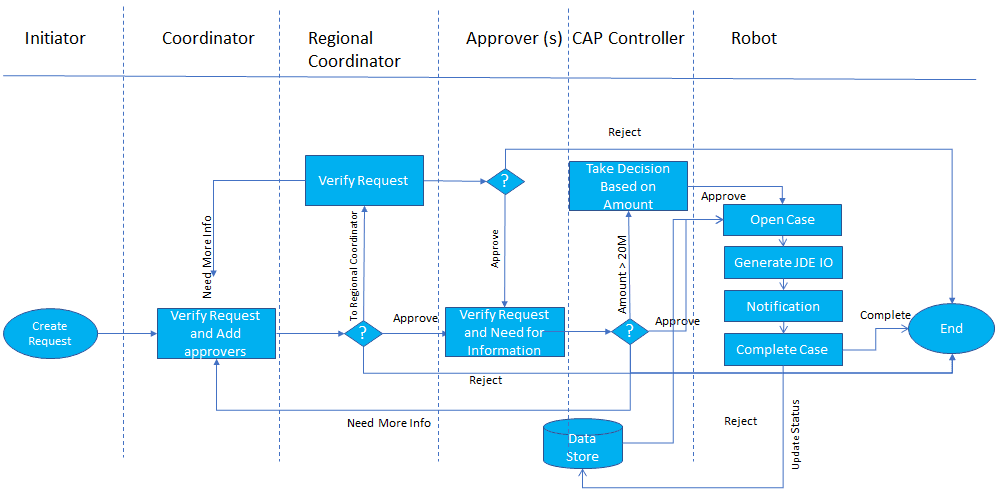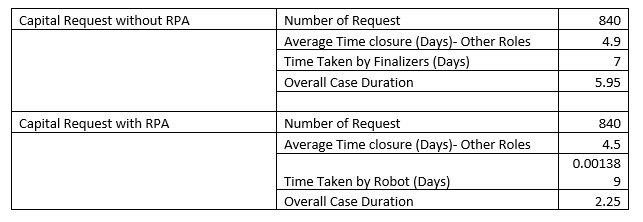By now, most enterprise leaders are well aware of the benefits of robotic process automation (RPA) – financial savings, improved quality and a better customer experience, just to name a few. RPA is an application of technology, governed by business logic and structured inputs, aimed at automating business processes. Using RPA tools, a company can configure software, or a “robot,” to capture and interpret applications for processing a transaction, manipulating data, triggering responses and communicating with other digital systems. With RPA, businesses can automate mundane rules-based business processes, enabling business users to devote more time to serving customers or other higher-value work.
On similar note, a case study was conducted on a Capital Approval tool (tool built for one of the customers) to verify the benefits and results of applying RPA to a business process with different roles activities. The results show that productivity improvement is the main benefit of RPA as well as time reduction achieved in this case.
Introduction
For any business process execution, different roles are involved in spending substantial time in dealing with downstream applications, i.e., Resource Planning, Customer Relationship Management (CRM), Payroll system etc.
Robotic process automation is designed to help primarily with office type functions, which requires the ability to do several types of tasks in order. This is in contrast to traditional manufacturing automation that focuses on taking one portion of a workflow or even just one task and creating a robot to specialize in it. Office work often requires the same types of repetition of jobs/task, but it is data being manipulated across downstream platforms and applications so a physical robot is not necessary. Instead a software robot is deployed with the ability to launch and operate other software. RPA works like a digital assistant for workers by clearing the onerous, simple tasks that eat up part of every office worker’s day. Simplicity and relative low costs can make RPA a more attractive solution for many companies, particularly if the company has legacy systems and applications. Robotic process automation is designed to play nice with most legacy systems and applications, making it easier to implement compared to other enterprise automation solutions.
Consider that some highly structured, routine and manual tasks could be handled by a robot, so that skilled workers have more time for value added tasks. This is the promise or Robotic Process Automation (RPA) that has emerged in the last five years as a set of software tools and automation platforms that can automate tasks on rules-based business processes. Robots in the RPA processes or systems or tools doesn’t exactly mean physical robots, but instead it means that there are software blocks or applications that can take over responsibilities or tasks from Humans. These are tasks that can be performed by robots more quickly and efficiently.
While existing capabilities of screen-scraping and macros software technology may come to mind, RPA is an evolution beyond these solutions. RPA is becoming an important automation tool driving digital transformation and the future of work. As a user-friendly and cost-effective tool, robotic process automation provides a number of advantages that are drawing interest from different organizations across many industries.
The industry benefits of RPA include –

Extreme accuracy: Bots are extremely accurate and consistent – they are much less prone to making mistakes or typos than a human worker. Higher percentages of mistakes and typos have been observed when humans are copying data or feeding other systems.
No programming skills: To configure a software robot, you don’t need to be expert in programming. As this is code-free technology, any non-technical staff can use a drag and drop process designer to set up a required bot or even record their own steps to automate a process through a process recorder feature. Once the bot is deployed, it would execute same steps.
Regulatory compliance: Bots only follow the instructions they have been configured to follow and provide an audit trail history for each step. Several aspects of compliance oversight operations can be enhanced through robot implementation. Monitoring and testing is an especially promising automation candidate. RPA’s capability to pull and aggregate data from multiple sources could also enhance the efficiency of regulatory, non-financial, and risk reporting as it can help eliminate or reduce the time-consuming processes of collecting, compiling, and cleansing, and summarizing large amounts of information. The controlled nature of bot work makes them suited to meeting even the strictest compliance standards
No impact on existing technology: RPA involves no disruption to underlying systems or technologies. Robots work across the presentation layer of existing applications just as a person does. Robots are useful for legacy systems, where APIs may not be immediately available, or in situations where organizations do not have the skilled resources to develop a deep level of integration with existing legacy applications.
Improved productivity: Robots process cycle times are fixed and more efficient and can be completed at a faster speed compared with manual process approaches where humans are involved.
Reliability: Operations can be performed 24/7 as these bots can work tirelessly and autonomously without requiring staff to manually trigger bots to initiate. If a human does need to intervene, it is to make a decision or resolve an error.
Consistency: RPA also offers the benefit of consistency of process. These bots can perform routine tasks same way each and every time based on defined captured flow.
Improved morale: RPA can handle some of the most routine tasks a business completes each day. Bots enable workers to offload manual offload tasks like filling out forms, data entry and looking up information from websites. This will improve morale in the HR and administrative areas of your business, which are crucial to helping your business grow. Employees will have more time to invest their talents in more engaging and interesting work.
Case Study
This case study was carried out on a Healthcare provider firm. As part of organizational strategy, the company created a shared platform to manage process automation, innovation and better customer experience. This was all orchestrated using BPM (Business Process Management) and hosted a number of processes.
To understand RPA and the benefits associated with it, company started by evaluating and prototyping this automation technology on some of its customer business process – Capital Approval process.
Figure 1 is the AS-IS process. Once a case is approved by all roles, then finalizers logged in to the approval digital tool to open the case and at the same time create case in JDE system with relevant detail taken from approval tool and generate the JDE IO number. This whole process is manual and often leads to error.

Figure 1: Capital Approval AS-IS process.
Figure 2 is the TO-BE automated process. The finalizer’s role activities were assumed by a software robot (RPA). After the case approval is done by other process roles, the robot accesses the data store, creates the case in the JDE system and generates JDE IO number, copies the JDE IO and pastes it on the approval tool to complete the case and generates notification for case completion.

Figure 2: Capital Approval TO-BE process with RPA.
Results
To evaluate results of TO-BE process implementation, capital request were monitored in two sets, one set with finalizers and another set without finalizers (Finalizers replaced with Robot) as finalizers activities were performed by robot. The measure used for evaluating the results was case duration for fixed number for requests. With RPA, overall duration reduced by 62% and finalizers duration reduced drastically by 99.99%. The results may vary based on the nature of the process.

The Need for an RPA Center of Excellence
We must have heard so far about technology, quality, project management and some other Center of Excellence (CoE) but not about RPA. When the number of automated processes increases, RPA becomes more complicated hence RPA requires a suitable operating and governance model for effective implementation. After RPA implementation, it doesn’t mean that we don’t need expertise to maintain robots. A CoE is essentially the way to embed RPA deeply and effectively into the organization, and to redistribute accumulated knowledge and resources across future deployments. The structure for RPA can consist of many teams across the organization and CoE can support those teams. Identify an RPA sponsor, change manager, solution architects, developers, infrastructure and service support to take on key roles in the RPA CoE and they can work across different implementation. The team needs to understand how to work well together and with stakeholders to deploy automation technology, adhere to standard processes and procedures, and measure business metrics and performance goals, including return on investment and customer satisfaction.
All automations can’t be candidates for RPA hence CoE can also work across the organization units with the primary objective of identifying processes, priorities processes for automation and then developing processes in robotic software before they go into production. They can also take care of controlling and monitoring the robot in production.
In the above case study, the RPA team interacted and collaborated with Capital tool development, support, business, testing CoE, and the change management team. This collaboration can be governed by CoE to meet strategic objectives and outcomes.
Conclusion
This article has covered what Robotic Process Automation means, the benefits that an Organization can enjoy when implementing Robotic Process Automation and also need of RPA center of excellence which can help effective implementation. When deciding on the use of RPA, companies should consider that RPA is more suitable for high volume standardized tasks that have rules and driven by fixed paths and where there is no need for subjective judgement, creativity or interpretation skills. In the above case study, the finalizer role was never involved in subjective judgement hence it was acknowledged as a suitable candidate for RPA implementation.
The main benefits of RPA are cost reduction, increasing process speed, error reduction (as robots follow the instruction which have been provided) and productivity improvement by reducing execution duration as the case study reveals.
The post Robotics Process Automation: The New Digital Assistant appeared first on Simple Talk.
from Simple Talk http://bit.ly/2SDqA2g
via
I agree with a lot of the points you made in this article. If you are looking for the Rpa Solutions, then visit Neebal. I appreciate the work you have put into this and hope you continue writing on this subject.
ReplyDeleteWe impressed on Case Study! Great info about RPA... IT Technology consulting firm Texas | Robotic Process Automation Consulting Services Texas
ReplyDeleteI just needed to record a speedy word to express profound gratitude to you for those magnificent tips and clues you are appearing on this site
ReplyDeleteCRM Software
Wonderful blog..!! Reference links are similar to the topic that I’m looking for.
ReplyDeleteAngularJS Course in Chennai
RPA Course in Chennai